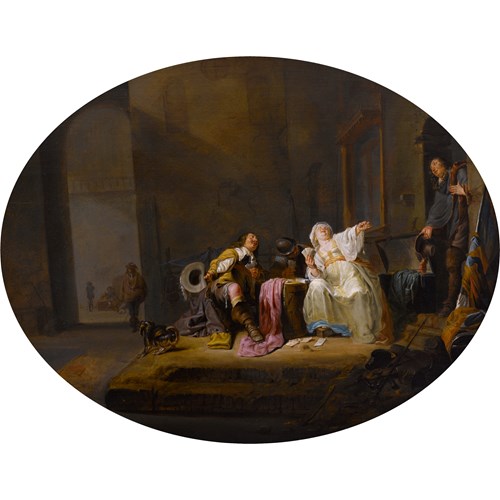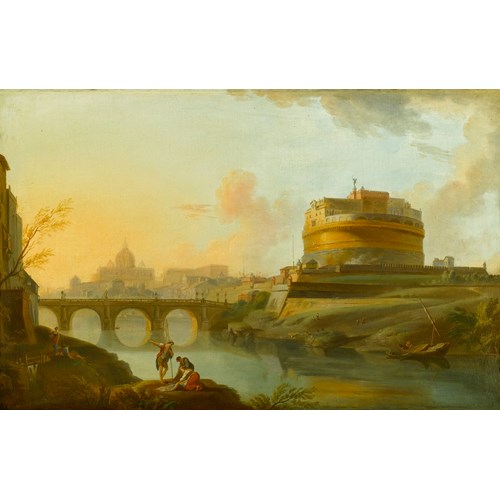Marketplace
Study of a Cossack
Franz Alekseevich Roubaud
Study of a Cossack
Epoque 1850-1900, 19th century, 20th century
Origine Ukraine, Germany
Medium Oil on canvas
Dimension 25 x 20.5 cm (9⁷/₈ x 8¹/₈ inches)
This delicate study shows a Cossack, deep in thought. It is a particularly intimate moment as Franz Alekseevich Roubaud focuses solely on the head and shoulders of the man to convey the deeper thoughts and emotion within. His eyes are cast downwards looking at something unknown to the viewer whilst a cigarette is smoked almost to the filter. Roubaud deftly applies light, sweeping movements of his brush to replicate soft sunlight falling on the brow, beard, and right shoulder of the man.
The man wears a brown tunic, and the red crown of his fleece hat suggests he could perhaps be identified as a Kuban Cossack. Kuban is in the south of Russia and surrounds the Kuban River on the Black Sea between the Don Steppe, Volga Delta and the Caucasus. Although the Kuban Cossacks were established in 1864, they were descendants of the Black Sea Cossacks (originally the Zaporozhian Cossacks) and the Caucasus Line Cossacks. However, this identification cannot be certain as Cossacks were expected to provide their own uniforms, and there was no accepted pattern or insistence on any such outfits. While these were sometimes manufactured in bulk by factories owned by the individual Host, garments were often handed down or cut out within a family. Nineteenth-century plates engraved in St. Petersburg for military magazines show Cossacks superbly turned out. However, this idealism is challenged by photography from the end of the century showing Cossacks riding unkempt ponies, just as they themselves appear ungroomed.
The word ‘Cossack’ derives from the Turkic term kazak which means ‘free man’ or ‘adventurer’. Cossacks consisted of semi-independent Tartar groups, or peasants escaping serfdom in Poland and Russia. Throughout the sixteenth and seventeenth centuries, Cossacks lived in the south-eastern frontier of the former Polish Republic (the territories now belonging to Ukraine), then called Zaporozhe, on the banks of the Dnieper river. In 1893, the year this study was completed, Cossacks numbered a total population of 2,648,049 (including 1,331,470 women) and they owned nearly 146,500,000 acres (593,000 km²) of land, including 105,000,000 acres (425,000 km²) of arable land and 9,400,000 acres (38,000 km²) of forest throughout Russia. At the end of the nineteenth century the Cossacks found themselves the tools of Tsarist oppression, stamping out revolutionary activities and escorting political prisoners to the East.
Born in Odessa in 1856, Roubaud moved to Munich at the age of twenty one to study under the genre painters Carl von Piloty (1826-1886) and Otto Seitz (1846-1912). Later, in 1881, he studied under Josef von Brandt, the famous Polish battle painter.
In 1883 Roubaud received a commission from the Russian government to travel through the Caucasus and in 1885 he executed a series of history paintings. Roubaud created three panoramas, the most famous being the extraordinary 115 metre-long The Battle of Borodino (1911, moved to Poklonnaya Hill in Moscow in 1962) and the Siege of Sevastopol, the last major siege of the Crimean War (1854); damaged during the Siege of Sevastopol (1942). This work was unveiled in 1905, having taken him three years to complete in Munich. His works were so large that they had to be exhibited in pavilions specially built for that purpose. From 1908 to 1911 he taught as a professor at the Academy of Fine Arts in St. Petersburg. In 1913, he left Russia for Munich, where he died on 13th March 1928.
The man wears a brown tunic, and the red crown of his fleece hat suggests he could perhaps be identified as a Kuban Cossack. Kuban is in the south of Russia and surrounds the Kuban River on the Black Sea between the Don Steppe, Volga Delta and the Caucasus. Although the Kuban Cossacks were established in 1864, they were descendants of the Black Sea Cossacks (originally the Zaporozhian Cossacks) and the Caucasus Line Cossacks. However, this identification cannot be certain as Cossacks were expected to provide their own uniforms, and there was no accepted pattern or insistence on any such outfits. While these were sometimes manufactured in bulk by factories owned by the individual Host, garments were often handed down or cut out within a family. Nineteenth-century plates engraved in St. Petersburg for military magazines show Cossacks superbly turned out. However, this idealism is challenged by photography from the end of the century showing Cossacks riding unkempt ponies, just as they themselves appear ungroomed.
The word ‘Cossack’ derives from the Turkic term kazak which means ‘free man’ or ‘adventurer’. Cossacks consisted of semi-independent Tartar groups, or peasants escaping serfdom in Poland and Russia. Throughout the sixteenth and seventeenth centuries, Cossacks lived in the south-eastern frontier of the former Polish Republic (the territories now belonging to Ukraine), then called Zaporozhe, on the banks of the Dnieper river. In 1893, the year this study was completed, Cossacks numbered a total population of 2,648,049 (including 1,331,470 women) and they owned nearly 146,500,000 acres (593,000 km²) of land, including 105,000,000 acres (425,000 km²) of arable land and 9,400,000 acres (38,000 km²) of forest throughout Russia. At the end of the nineteenth century the Cossacks found themselves the tools of Tsarist oppression, stamping out revolutionary activities and escorting political prisoners to the East.
Born in Odessa in 1856, Roubaud moved to Munich at the age of twenty one to study under the genre painters Carl von Piloty (1826-1886) and Otto Seitz (1846-1912). Later, in 1881, he studied under Josef von Brandt, the famous Polish battle painter.
In 1883 Roubaud received a commission from the Russian government to travel through the Caucasus and in 1885 he executed a series of history paintings. Roubaud created three panoramas, the most famous being the extraordinary 115 metre-long The Battle of Borodino (1911, moved to Poklonnaya Hill in Moscow in 1962) and the Siege of Sevastopol, the last major siege of the Crimean War (1854); damaged during the Siege of Sevastopol (1942). This work was unveiled in 1905, having taken him three years to complete in Munich. His works were so large that they had to be exhibited in pavilions specially built for that purpose. From 1908 to 1911 he taught as a professor at the Academy of Fine Arts in St. Petersburg. In 1913, he left Russia for Munich, where he died on 13th March 1928.
Epoque: 1850-1900, 19th century, 20th century
Origine: Ukraine, Germany
Medium: Oil on canvas
Signature: Signed 'F. Roubaud' (lower right)
Dimension: 25 x 20.5 cm (9⁷/₈ x 8¹/₈ inches)
Plus d'œuvres d'art de la Galerie









